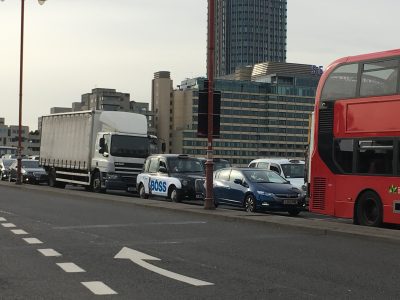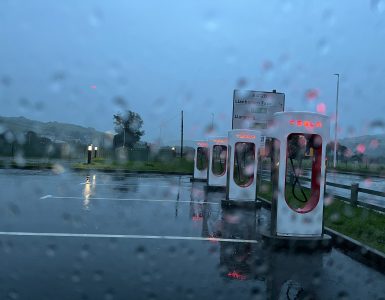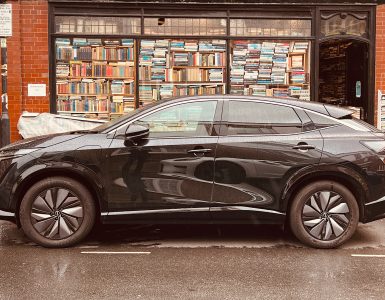The London ULEZ (or Ultra Low Emission Zone) was the first UK clean air zone and it’s criteria for charging the most polluting vehicles has been rolled out as the standard for other clean air zones in the UK. In late 2021 it is being expanded in London to cover all roads within the North and South Circular roads. However it has a fatal flaw. Fatal for its effectiveness which will decline every year and fatal to the health of Londoners who want and expect air quality to improve and continue to improve. The flaw will also prevent the current ULEZ from supporting the transition to a zero carbon economy.
The fatal flaw – the ULEZ was designed to be less effective at cutting air pollution every year
There were always 2 problems problem with the existing criteria for the London ULEZ called Euro 6 emissions standard.
- The ULEZ imposes a daily levy on driving diesel vehicles that fail to comply with the Euro 6 emissions standard (most diesels sold before Sept 2015) but exempts the Euro 6 diesels sold since that date. This could have made sense if these vehicles were dramatically cleaner than previous diesels but they weren’t.
Euro 6 diesels still produce NOx pollution well in excess of legal limits on the road and still do although those sold since September 2019 are closer to legal limits set in 2015 newer diesels still mostly exceed legal limits. The next Euro 7 standard which might be much tighter isn’t set to arrive till the mid 2020s. - By choosing the Euro 6 emissions standard to decide whether a diesel vehicle pays the daily ULEZ charge (and a much earlier date for petrol cars) the exemption date has been fixed to diesel cars & vans sold since September 2015.
This means the proportion of cars charged falls with every new year – each year a higher proportion of cars are ULEZ exempt and a smaller proportion pay it. By 2025 a 10 year old diesel will be exempt while in 2019 only diesels up to 4 years old were exempt.
Much of the benefit of the newly launched ULEZ didn’t just derive from newer diesels getting slightly cleaner but simply because in 2019 the ULEZ was only exempting 4 and a bit years of newer diesel sales. If you assume the average UK diesel car has a life of 14 years then
- in 2019 71% of diesel sales years had to pay the ULEZ while 29% were exempt. If no changes are made to ULEZ criteria this benefit to air quality goes into reverse and
- In 2021 50% of diesels are ULEZ exempt rising to
- 78% of diesels exempt by 2025 and only 22% liable for the charge
- by 2030 when almost every diesel in the UK would be exempt!
| Year | Current ULEZ exempt diesels |
|---|---|
| 2019 | 2015,2016,2017,2018,2019 (exempt up to 5 years old) |
| 2020 | 2015,2016,2017,2018,2019,2020 (exempt up to 6 years old) |
| 2021 | 2015,2016,2017,2018,2019,2020,2021 (exempt up to 7 years old) |
| 2022 | 2015,2016, 2017,2018,2019,2020,2021,2022 (exempt up to 8 years old) |
| 2023 | 2015,2016,2017,2018,2019,2020,2021,2022,2023 (exempt up to 9 years old) |
| 2024 | 2015,2016,2017,2018,2019,2020 2021,2022,2023,2024 (exempt up to 10 years old) |
| 2025 | 2015,2016,2017,2018,2019,2020,2021,2022,2023,2024,2025 (exempt up to 11 years old) |
| 2026 | 2015,2016,2017,2018,2019,2020,2021,2022,2023,2024,2025,2026 (exempt up to 12 years old) |
| 2030 | 2015,2016,2017,2018,2019,2020,2021,2023,2024,2025,2026,2027,2028,2029,2030 (exempt up to 15 yrs old) |
Not only will you soon have 10 years worth of polluting but ULEZ exempt diesels but by then these cars will be older, with poorly maintained or disabled Adblue systems & particulate filters producing increasing levels of NOx and diesel particulate filters emitting increasing particulate emissions.
=In other words without changing the ULEZ criteria, diesel emissions in London are likely to plateau and then worsen, limited only by falling new diesel car sales. Diesel share of new UK car sales declined from 50.1% in 2014 to 42% in 2017, then 31.7% in 2018, 26.6% in 2019 (these include MHEV diesels). Diesel share plateaued at just under 1 in 5 sales, largely keeping a foothold in the large luxury brand SUV segment then fell further at the end of 2021 to around 10% including MHEV diesels. It’s also worth remembering that over 95% of van sales are still diesels and it is vital new vans switch to electric now the choice of models is finally improving.
How clean are Euro 6 diesels on the road?
The chart below shows the real world diesel emissions of 70,000+ diesel cars by brand on the road in the Edinburgh & West Lothian study in 2017. To take Audi as an example when tested on the road their Euro 3 diesels were twice as polluting as the Euro 3 legal NOx pollution limit. Their Euro 4 & 5 Models also failed to meet their limits, in fact they also exceeded the Euro 3 legal limits by around 2x as well. Euro 6 Audi cars tested at the roadside did at last comply with with the Euro 3 standard but failed to meet even the Euro 4 and 5 standards on the road let alone the Euro 6 legal limit.

Euro 6 diesels sold since 2019 finally had to be tested in a real world environment. They still do not comply with legal limits however because manufacturers lobbied for a higher limit for the real world test. Although the European parliament has pressed for the Euro 6 legal limit to apply in the on the road RDE 1 and RDE2 tests, the EU has no plan or date for the 2015 legal limit ever to be applied in a real world test.
It also remains unclear even on the newest diesels whether carmakers are still using thermal envelopes to turn off pollution control equipment in many normal use environments. In this 2021 Austrian case it became clear for example that VW vehicles turn their pollution control adlblue systems down or off completely when the outside temperature is below 15C, above 33C sending pollution levels sky high in normal operating use. To our knowledge no carmaker has revealed its thermal envelopes except in court testimony where they describe it as perfectly legal under EU law.
What is the diesel sunset?
The idea is a pretty simple one that brings better return on capital and increased revenue over time but also maintains improvements in air quality and then drives further improvement.
You keep the ULEZ Euro 6 diesel exemption but each calendar year from 2022 you remove the exemption from the oldest 2 years worth of the Euro 6 models. This means in 2021 you peak at 7 year old diesels being exempt. In 2022 the oldest 2015 and 2016 diesels lose exemption and by 2023 Euro 6 diesels sold in 2015, 2016, 2017, and 2018 will have lost exemption. By 2026 only 2 year old diesels will be exempt diesels and in 2027 only diesels sold the same year will be exempt
| Year | Exempt Euro6 diesels |
|---|---|
| 2019 | 2015.2016,2017,2018,2019 (exempt up to 5 years old) |
| 2020 | 2015.2016,2017,2018,2019,2020 (exempt up to 6 years old) |
| 2021 | 2015,2016,2017,2018,2019,2020,2021 (exempt up to 7 years old) |
| 2022 | 2017,2018,2019,2020,2021,2022 (exempt up to 6 years old) |
| 2023 | 2019,2020,2021,2022,2023 (exempt up to 5 years old) |
| 2024 | 2021,2022,2023,2024 (exempt up to 4 years old) |
| 2025 | 2023,2024,2025 (exempt up to 3 years old) |
| 2026 | 2025,2026 (exempt up to 2 years old) |
| 2027 | 2027 (exempt up to 1 year old) |
Why this matters
- It’s based on sound science. It is overwhelmingly clear from studies that earlier Euro 6 diesels were massively more polluting than petrol cars
- While some newer diesels have improved even the latest RDE2 Euro 6 emissions standard still allows new diesels to produce far more NOx on the road than petrol cars.
- Even those diesels that pass RDE 1 or 2 on the road tests do so only when brand new and complex emissions control equipment is used and maintained perfectly. This equipment is expensive to maintain and replace and it is relatively easy for owners to circumvent expensive repairs allowing pollution to soar.
- The sunset is not draconian, indeed it is not until 2024 that the number exempt diesel sales years is less than when the ULEZ was introduced. By January 2022, just after the expanded ULEZ zone starts it is only diesels more than 6 years old that would lose exemption
- ”keep exemptions for 2015 and 16 diesel cars” hardly has the makings of a big viral campaign by motoring lobbyists so it should be less politically toxic than a diesel exhaust.
- The sunset restores the direction of travel to ULEZ policy and ends the rather ridiculous argument by some dieselmakers that Euro 6 diesels are no longer polluting because the Mayor says so by exempting them!
- We have not discussed petrol cars which are currently all exempt on a 14 year life basis. Obviously even a 2 year annual sunset on the petrol exemption would take around 6 years before a 10 year old petrol car loses it’s exemption
- The proposal also uses the existing infrastructure that is required for the ULEZ expansion in October 2021 and can therefore be rolled out at the same time
- It’s worth bearing in mind that very soon in 2025 the ULEZ criteria will reach a crescendo of absurdity. In only 4 years time under the Mayor’s plans Electric cars (EVs) will lose their London Congestion Charge exemption. At the same time 10 year old cars and vans will be exempt from the ULEZ charge or ultra low emissions charge. So in a 2025 London traffic jam a 10 year old diesel or 20 year old petrol car spewing out fumes will pay the same to drive in London as a the zero tailpipe emission EV
- This is an appalling prospect that removes any public policy purpose from the ULEZ unless a sunset is employed or diesel exemptions are removed altogether. The most obvious alternative way to deal with the ULEZ would be to do nothing till about 2023 then, once ULEZ is largely ineffective, shift the exemption date by 5 or more years in one go.. a “politically braver” move that would ignite opposition co-ordinated by the usual transport industry lobby groups.
Comparison with the alternative proposal being being considered by the Mayor of London for a £3.50 daily charge to enter a new zone of Greater London outside the ULEZ area.
Full details have not been published but based on what has been revealed so far…
This proposal was floated in December 2020 with this Guardian piece being the most friendly and has already produced a storm of protest in most of the newspapers. Here is how the proposal compares with our ULEZ sunset proposal.
| ULEZ Sunset | London £3.50 toll | |
| Runs on expanded ULEZ zone infrastructure | ✅ | ❌ |
| Can be implemented by January 2022 | ✅ | ❌ |
| Politically saleable to most drivers | ✅ | ❌ |
| Reduces ULEZ revenue | ❌ | ✅ |
| Targeted to cut exhaust pollution | ✅ | ❌ |
| higher revenue per charge event & no new infrastructure | ✅ | ❌ |
| solves issue of more older vehicles being ULEZ exempt raising pollution & reducing revenue each year | ✅ | ❌ |
| Congestion charge supplement of £2.50 or £3.50 can be added to outer ULEZ at any time | ✅ | ✅ |
On the criteria we believe are important we don’t think a third zone with a £3.50 toll makes sense, either to reduce pollution or congestion or to raise revenue
- It is expensive and time consuming to implement
- it is unclear the the boundary will be M25 which is the logical and simplest place for an outer zone boundary
- If it is purely a toll on entering London (rather than being enforced on all vehicles travelling inside the zone) it would encourage traffic to travel within London rather than going round M25 and having to re-enter London
- If it is set up to charge any cars travelling inside greater London then a vast new set of enforcement cameras would be needed but only raising £3.50 per vehicle per day. If you install that why not just expand the ULEZ to M25 boundary at the same time with the pollution and revenue benefits that would accrue.
- We believe if a reduced rate “Congestion charge light” is to be introduced it should be applied first within the expanded ULEZ zone. The entire zone can then be expanded towards or to the M25 boundary over time.
- It’s time the Mayor and TFL dealt with the ULEZ criteria flaw, continued to improve air quality and safeguard revenue and ensure policy encouraged sales of clean zero emission vehicles leading up to the 2030 ban.






